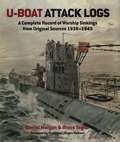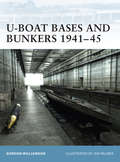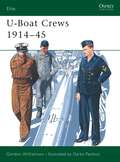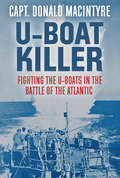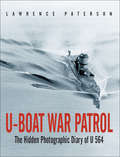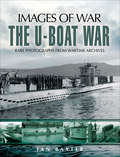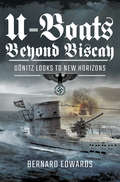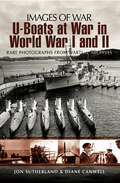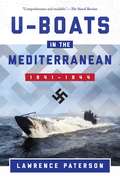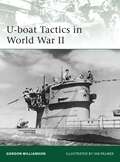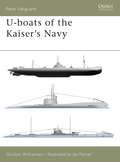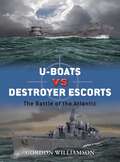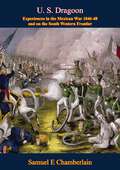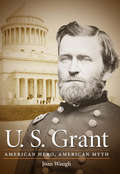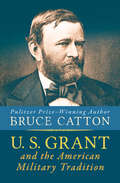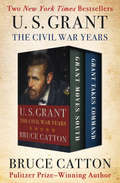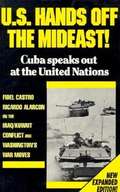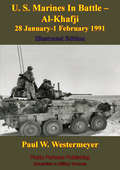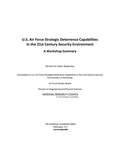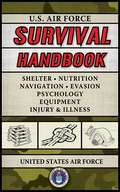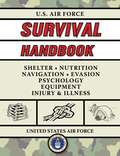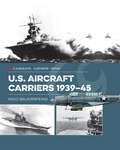- Table View
- List View
U-Boat Ace
by Jordan VauseAn exceptional figure in the history of the German Navy, Wolfgang Luth was one of only seven men in the Wehrmacht to win Germany's highest combat decoration, the Knight's Cross with Oak Leaves, Swords, and Diamonds. At one time or another he operated in almost every theater of the undersea war, from Norway to the Indian Ocean, and became the second most successful German U-boat ace in World War II, sinking more than 220,000 tons of merchant shipping. A master in the art of military leadership, Luth was the youngest man to be appointed to the rank of captain and the youngest to become commandant of the German Naval Academy. Nevertheless, his accomplishments were overshadowed by those of other great aces, such as Prien, Kretschmer, and Topp.The publication of this book in hardcover in 1990 marked the first comprehensive study of Luth's life. Jordan Vause corrects the long neglect by providing an entertaining and authoritative biography that places the ace in the context of the war at sea. This new paperback edition includes corrections and additional information collected by the author over the past decade.
U-Boat Attack Logs: A Complete Record of Warship Sinkings from Original Sources 1939–1945
by Daniel Morgan Bruce Taylor&“An indispensable reference work for anyone studying either the U-boat campaign or WW2 at sea . . . copiously illustrated, fascinating—and harrowing.&”—Navy News During the Second World War over 250 Allied warships from a dozen navies were sent to the bottom by German U-boats. This ground-breaking study provides a detailed analysis of every sinking for which source material survives from both the Allied and the German sides, resulting in detailed treatment of the fate of 110 vessels, with the remainder summarized in an extensive appendix. Uniquely, each entry is built around a specialist translation of the relevant segment of the war diary (log) of the U-boat in question, taken directly from the surviving originals—remarkably, this represents the first large-scale publication of the U-boat war diaries in any language. The book offers a wealth of new information, not only with respect to the circumstances of the sinkings from both the Allied and German perspectives, but also to the technical environment in which they lived as well as the fate of the crews. The entries include background details on the vessels concerned and the men involved, with a selection of rare and carefully chosen photos from archives and collections around the world. Each entry is itself a compelling narrative, but is backed with a list of sources consulted, including documents, published works and websites. A decade in the making, this is probably the most important book on the U-boat war to be published for many a year. &“Offers significant new information on many of the most famous incidents.&”—Maritime Advisor
U-Boat Bases and Bunkers 1941-45
by Ian Palmer Gordon WilliamsonFew of the massive military structures built by Germany during World War II are as impressive as the U-Boat bases and bunkers in Germany, Norway and France. This title takes a close look at the formidable edifices on the French coast (Brest, Lorient, St Nazaire, La Pallice, Bordeaux) in Norway (Bergen, Trondheim) and Germany (Keil, Hamburg, Helgoland) and also focuses on the huge 'Valentin' factory complex at Bremen, which manufactured the new type XXI electro-boats. Bunker protective systems, such as camouflage, light and heavy flak installations and nearby air cover, are also examined as well as resident flotillas and the fate of the bases at war's end.
U-Boat Crews 1914-45
by Darko Pavlovic Gordon WilliamsonOsprey's study of the U-Boat and its crews during World War I (1914-1918) and World War II (1939-1945). If one single weapon in Germany's arsenal can be said to have come closest to winning the war for the Third Reich, it was without doubt the U-Boat. German U-Boat technology, training, tactics and combat successes far exceeded those of any of the other combatant nations, and even as the Third Reich was crumbling, technically advanced vessels such as the Type XXI, many years ahead of its time, were being put into volume production. Gordon Williamson provides a fascinating overview of the achievements of the U-Boat Waffe in both wars, together with a study of the uniforms and insignia worn by U-Boat crews.
U-Boat Killer
by Captain Donald MacIntyreU-Boat Killer, first published in 1956, is an exciting account of a British Royal Navy destroyer in World War II. Tasked with guarding vital Atlantic convoys and later commanding 'Hunter/Killer' groups, author Captain Donald MacIntyre (1904-1981) became a near-legend during the war, with 7 destroyed German submarines to his credit, as well as several U-boat captures. He also survived a torpedo hit, and, after ramming a U-boat, successfully piloted the damaged ship back to safety.
U-Boat War Patrol: The Hidden Photographic Diary of U-564
by Lawrence PatersonThis is the third of three volumes describing U-boat operations in the Atlantic during the Second World War.This is the fascinating account, as told from the German perspective, of the Battle of the Atlantic, the longest-running, continuous military campaign in World War II, spanning from 1939 through to Germany's defeat in 1945. At its core was the Allied naval blockade of Germany, which was announced the day after the declaration of war, although it quickly grew to include Germany's counter-blockade. The name "Battle of the Atlantic", was coined by Winston Churchill in 1941 and he famously stated that the U-boats were the only thing that really frightened him. The U-boat war encompassed a campaign that began on the first day of the European war and lasted for six years, involved thousands of ships and stretched over thousands of square miles of ocean, in more than 100 convoy battles and perhaps 1,000 single-ship encounters. In the 68 months of World War II, 2,775 Allied merchant ships were sunk for the loss of 781 U-boats.This is the story of that massive encounter from the German perspective. Published in three volumes, this work was compiled under the supervision of the U.S Navy Department and the British Admiralty by Fregattenkapitan Gunther Hessler. The author, though without previous experience as a writer, had first hand experience of U-boat warfare having commanded a U-boat in 1940 and 1941. For the remainder of the war he was Staff Officer to the Flag Officer commanding U-boats. He had access to German war diaries and other relevant documents concerning U-boat command, and this work based on these many documents, tells the story entirely from the viewpoint of that command. For this reason this work is essential reading for anyone interested in the history of World War II from primary sources and will be of enduring interest to those engaged in attempting to unravel the true nature of submarine warfare in World War II.
U-Boat War: Rare Photographs from Wartime Archives (Images of War)
by Ian Baxter2.20PM Directly in front of us I sighted four funnels and the masts of a passenger steamer at right angles to our course coming from the SW and going towards Galley Head. 3:10 PM Torpedo shot at a distance of 700 meters below the surface - from the log of the German submarine U–20. The explosion that followed changed history as the date of the ship's log was may 7, 1915, the steamer was the Lusitania, and the torpedo sent 1195 innocent men, women, and children to a watery grave. In 1914, U-Boats were a new and untried weapon, and when such a weapon can bring a mighty empire to the briink of defeat there is a story worth telling. Edwyn Gray's The U-Boat War is the history of the Kaiser's attempt to destroy the British Empire by a ruthless campaign of unrestricted submarine warfare. It opens with Germany's first tentative experiments with the submarines and climaxes with the naval mutiny that helped bring down the Kaiser. In between is is a detailed account of a campaign of terror which, by April 1917,had the British Empire on the verge of surrender. The cost in lives and equipment was staggering. On the German side, 4894 sailors and 515 officers lost their lives in action; 178 German Submarines were destroyed by the allies; 14 were scuttled and 122 surrendered. According to the most reliable sources, 5,708 ships were destroyed by the U-Boats and 13,333 non-combatants perished in British Ships. World figures for civilian casualties were never released The U-Boat War is a savage but thrilling account of men fighting for their lives beneath the sea, and of the boats that changed the face of naval warfare.
U-Boats Beyond Biscay: Dönitz Looks to New Horizons
by Bernard EdwardsOn the outbreak of war in 1939 Admiral Donitzs U-boat flotillas consisted of some thirty U-boats fully operational, with only six to eight at sea at any one time. Their activities were restricted mainly to the North Sea and British coastal waters. When France fell in the summer of 1940, the ports in the Bay of Biscay gave direct access to the Atlantic, and the ability to extend their reach even to. The Royal Navy was unable to escort convoys much beyond the Western Approaches. In a short time, the Allies were losing 500,000 tons of shipping a month, every month. Donitz now looked over the far horizons, Americas Eastern Seaboard, the coasts of Africa, and the Mediterranean, where Allied merchantmen habitually sailed alone and unprotected. There was a rich harvest to be gathered in by the long range U-boats, the silent hunter-killers, mostly operating alone. This book tells their story.
U-Boats at War in World War I and II: Rare Photographs From Wartime Archives (Images of War)
by Diane Canwell Jon SutherlandA photographic history of German submarines in the world wars, including unseen images from the personal collections of captains and crew. U-boats were the scourge of the seas for Allied shipping during both world wars, almost bringing Britain to the brink of starvation on several occasions. This book contains unseen photographs taken by German submarine crew and captains during each war. The World War One selection features a submariner&’s photos of U-25, an early German U-boat. They belonged to WO Friedrich Pohl, who served on U-boats SM-25 and SMU-33. There are many photos of the U-boat itself, crew on deck, and attacks on Norwegian merchant ships with the surface gun. U-25 was launched July 12, 1913, sank a total of twenty-one ships and 14,126 tons, and surrendered to France on February 23, 1919. The World War Two photos include images from an original WW2 U-boat commander&’s photo album. It belonged to Kapitan Leutnant Herbert Bruninghaus. As a U-boat navigator, he served on the famous U-38 under ace Heinrich Liebe. Bruninghaus later went on to command three U-boats of his own: U-6, U-148, and U-1059. There are also original images from a Kriegmarine officer&’s photo album (unfortunately unnamed), including photos of Commander Prien&’s U-47 returning to Kiel after attacks at Scapa Flow.
U-Boats in the Mediterranean: 1941–1944
by Lawrence PatersonBetween September 1941 and May 1944, the Germans sent sixty-two U-boats into the Mediterranean. To get there, the boats had to pass through the Strait of Gibraltar?the British-held entry point, where nearly a third of them were sunk or forced to turn back. Of the submarines that made it into the clear, calm waters of the Mediterranean, not one of them ever made it back into the Atlantic: They were all either sunk in battle or scuttled by their own crews. In U-Boats in the Mediterranean, Lawrence Paterson puts the campaign into its strategic context, showing how it coordinated with Rommel's Afrika Korps in the Western Desert and the U-boat battle in the Atlantic. He describes the weapons and tactics the commanders used to try to overcome the difficulties of operating in the shallow waters and and how increasing Allied dominance of the air took its heavy toll. Paterson details the U-boat triumphs such as the sinking of HMS Ark Royal, and the torpedoing of the battleship HMS Barham, which provided one of the best-known images of the Second World War at sea. Making full use of firsthand accounts by veterans, official German records, and Allied archives, the book puts a spotlight on a neglected aspect of the U-boat war and shows the courage and fortitude of the men on both sides of this savage conflict.
U-Boats off the Outer Banks: Shadows in the Moonlight (Military)
by Jim BunchFrom January to July 1942, more than seventy-five ships sank to North Carolina’s “Graveyard of the Atlantic” off the coast of the Outer Banks. German U-boats sank ships in some of the most harrowing sea fighting close to America’s shore. Germany’s Operation Drumbeat, led by Admiral Karl Donitz, brought fear to the local communities. A Standard oil tanker sank just sixty miles from Cape Hatteras. The U-85 was the first U-boat sunk by American surface forces, and local divers later discovered a rare Enigma machine aboard. Author Jim Bunch traces the destructive history of world war on the shores of the Outer Banks.
U-boat Tactics in World War II
by Gordon WilliamsonOsprey's elite title on Germany's U-Boat tactics during World War II (1939-1945). At the start of the war, German U-boat technology vastly out performed that possessed by the Allies, and under the pressure of the war continual development helped keep pace with wartime needs and improvements in anti-submarine weaponry. But it was not just the technology that had to change. German U-boat tactics evolved over time. Used in a variety of roles, from coastal patrolling through to the combined actions of convey-hunting 'wolf packs', the tactics used by U-Boats were diverse. This book analyses how the U-boats dominated the seas thanks to their innovative and daring tactical deployment, and how the cracking of the Enigma code effectively hamstrung them, greatly reducing their impact, a problem that even their advanced tactics failed to solve.
U-boats of the Kaisers Navy
by Ian Palmer Gordon WilliamsonAs was the case in World War II, one of the greatest threats to Britain during World War I was the German U-boat menace. This book traces the development of the U-boat threat from the Brandtaucher, designed by Wilhelm Bauer, the father of the German submarine arm, in 1850, through to the commissioning of Germany's first U-boat to go into service, the U-1, in 1906. It then covers the main types of World War I U-boat, detailing the operational history of the U-boat service in depth, with a particular focus on the campaigns in the Atlantic and Mediterranean, as well as the slow build up of anti-submarine measures by the allies.
U-boats vs Destroyer Escorts
by Gordon WilliamsonWinston Churchill claimed that the "U-boat peril" was the only thing that ever frightened him during World War II. A formidable foe, the U-boat was developed from a small coastal vessel into a state-of-the-art killer, successfully stalking the high seas picking off merchant convoy ships. It was not until the destroyer escort was introduced, alongside the development of destroyer groups with dedicated anti-submarine tactics, that there was an effective means of defence and attack against the U-boat peril.Gordon Williamson describes the design and development of these two deadly opponents, their strengths and weaknesses and of their tactics, weaponry and training. He provides an insight into the lives of the Allied Navy and Wolf Pack crews as they played their deadly games of cat and mouse on the high seas, gambling not only with their lives but with the fate of their nations.
U. S. Dragoon: Experiences in the Mexican War 1846-48 and on the South Western Frontier
by Samuel E Chamberlain“From soldier to wagon master to scalp hunterChamberlain left Boston as a mere youth and joined the United States Army. He became a soldier in the 1st US Dragoons and determined to become the very ideal of the daring cavalryman both on and off the battlefields of the American-Mexican War. His is a tale—not a little tall—that includes accounts of passionate love affairs, duels to the death, pitched battles and exploits of daring in which Chamberlain himself features as the central heroic figure. Certainly he was a larger than life character, as his accounts of constant troubles with his superiors for brawling, drunkenness and insubordination appear with a detail and frequency which suggest authenticity. At the end of the war Chamberlain became a wagon master—possibly after deserting the army—and then threw himself into a series of adventures with a notorious band of scalp hunters led by the infamous John Glanton. A highly entertaining and informative account of the United States cavalry at war, in which many of the principal characters of the American Civil War—who appear within its pages—learned their craft.”-Print ed.
U. S. Grant
by Joan WaughAt the time of his death, Ulysses S. Grant was the most famous person in America, considered by most citizens to be equal in stature to George Washington and Abraham Lincoln. Yet today his monuments are rarely visited, his military reputation is overshadowed by that of Robert E. Lee, and his presidency is permanently mired at the bottom of historical rankings. In U. S. Grant, Joan Waugh investigates Grant's place in public memory and the reasons behind the rise and fall of his renown, while simultaneously underscoring the fluctuating memory of the Civil War itself.
U. S. Grant and the American Military Tradition
by Bruce CattonA fascinating and insightful examination of the life and times of the victorious Civil War general who became a controversial American president In U. S. Grant and the American Military Tradition, Pulitzer Prize-winning historian Bruce Catton explores the life and legacy of one of the nation's greatest and most misunderstood heroes, before, during, and after the terrible War Between the States that violently split the country in two. Beginning with Ulysses S. Grant's youth in Ohio and his service as a young lieutenant under General Zachary Taylor in the Mexican-American War, the story continues through Grant's post-war disgrace, his forced resignation for drinking, and his failures as a citizen farmer and salesman. But after the Civil War broke out, Grant rose from the rank of an unknown solider to commanding general of the US Army, finding redemption as the military savior of the embattled Union. Proving his reputation as America's premiere expert on the Civil War, Catton examines Grant's campaigns in enthralling detail, including Fort Henry; Shiloh; the Siege of Vicksburg, which set the Confederate enemy on the inevitable road to defeat; and Robert E. Lee's surrender at Appomattox Court House, which solidified Grant as a figure of national acclaim. Catton then explores Grant's two-term presidency and final years, casting an illuminating new light on a complex and controversial national figure whose great accomplishments have all too often been downplayed or overlooked.
U. S. Grant: Grant Moves South and Grant Takes Command
by Bruce CattonPulitzer Prize–winning historian Bruce Catton&’s acclaimed two-book biography of complex and controversial Union commander Ulysses S. Grant. In these two comprehensive and engaging volumes, preeminent Civil War historian Bruce Catton follows the wartime movements of Ulysses S. Grant, detailing the Union commander&’s bold tactics and his relentless dedication to achieving the North&’s victory in the nation&’s bloodiest conflict. While a succession of Union generals were losing battles and sacrificing troops due to ego, egregious errors, and incompetence in the early years of the war, an unassuming Federal army colonel was excelling in the Western theater of operations. Grant Moves South details how Grant, as commander of the Twenty-First Illinois Volunteer Infantry, though unskilled in military power politics and disregarded by his peers, was proving to be an unstoppable force. He won victory after victory at Belmont, Fort Henry, and Fort Donelson, while sagaciously avoiding near-catastrophe and ultimately triumphing at Shiloh. His decisive victory at Vicksburg would cost the Confederacy its invaluable lifeline: the Mississippi River. Grant Takes Command picks up in the summer of 1863 when President Abraham Lincoln promoted Grant to the head of the Army of the Potomac, placing nothing less than the future of an entire nation in the hands of the military leader. Grant&’s acute strategic thinking and unshakeable tenacity led to the crushing defeat of the Confederacy in the Overland Campaign in Virginia and the Siege of Petersburg. In the spring of 1865, Grant finally forced Robert E. Lee&’s surrender at Appomattox Court House, ending the brutal conflict. Although tragedy struck only days later when Lincoln was assassinated, Grant&’s triumphs on the battlefield ensured that the president&’s principles of unity and freedom would endure. Based in large part on military communiqués, personal eyewitness accounts, and Grant&’s own writings, this engrossing two-part biography offers readers an in-depth portrait of the extraordinary warrior and unparalleled strategist whose battlefield brilliance clinched the downfall of the Confederacy in the Civil War.
U. S. Hands Off the Mideast! Cuba Speaks Out at the United Nations
by Fidel Castro Ricardo Alarcón Mary-Alice WatersFailure to attain a political solution would be a defeat for humanity. For every life lost on the battlefields of the Arab Persian Gulf, a thousand persons will die of hunger in the Third World. Such a fate would be unavoidable. Fidel Castro. Is it really the need to promote respect for the independence, sovereignty, and territorial integrity of states that motivates the United States? Or is it the ambition of the United States to intervene and dominate the Middle East? Ricardo Alarcon. Since the onset of the crisis in the Middle East that began with Iraq's invasion of Kuwait, only one world power Cuba has consistently spoken out against Washington's accelerating war preparations in the region and the horrible consequences entailed for the great majority of humanity. This book contains the statements by Cuban Ambassador to the United Nations Ricardo Alarcon and President Fidel Castro as the crisis has unfolded, together with each of the resolutions approved by the UN Security Council. In their statements, the Cuban leaders rebut the pretexts and arguments used by Washington to justify its unilateral acts of aggression. This is indispensable reading for all those concerned about the U.S. government's march toward war.
U. S. Marines In Battle - Al-Khafji 28 January-1 February 1991 Operation Desert Storm [Illustrated Edition]
by Paul W. WestermeyerIncludes over 20 maps, diagrams and illustrations."The Battle of Khafji was the first major ground engagement of the Gulf War. It took place in and around the Saudi Arabian city of Khafji, from 29 January to 1 February 1991 and marked the culmination of the Coalition's air campaign over Kuwait and Iraq, which had begun on 17 January 1991.Iraqi leader Saddam Hussein, who had already tried and failed to draw Coalition troops into costly ground engagements by shelling Saudi positions and oil storage tanks and firing Scud surface-to-surface missiles at Israel, ordered the invasion of Saudi Arabia from southern Kuwait. The 1st and 5th Mechanized Divisions and 3rd Armored Division were ordered to conduct a multi-pronged invasion toward Khafji, engaging American, Saudi and Qatari forces along the coastline. These three divisions, which had been heavily damaged by Coalition aircraft in the preceding days, attacked on 29 January. Most of their attacks were repulsed by U.S. Marines as well as U.S. Army Rangers and Coalition aircraft, but one of the Iraqi columns occupied Khafji on the night of 29-30 January. Between 30 January and 1 February, two Saudi Arabian National Guard battalions and two Qatari tank companies attempted to retake control of the city, aided by Coalition aircraft and American artillery. By 1 February, the city had been recaptured at the cost of 43 Coalition servicemen dead and 52 wounded. Iraqi Army fatalities numbered between 60 and 300, while an estimated 400 were captured as prisoners of war.The battle serves as a modern demonstration that air power in a supporting role to ground forces can be of great assistance in halting and defeating a major ground operation. It was also a major test of the Saudi and Qatari armies. Although the capture of Khafji was a propaganda victory for the Ba'athist Iraqi government, its subsequent recapture by Saudi and Qatari ground forces provided a major morale boost for Coalition forces."-Wiki
U. S. Naval Academy
by Thomas J. CutlerThe U. S. Naval Institute Chronicles series focuses on the relevance of history by exploring topics like significant battles, personalities, and service components. Tapping into the U. S. Naval Institute's robust archives, these carefully selected volumes help readers understand nuanced subjects by providing unique perspectives and some of the best contributions that have helped shape naval thinking over the many decades since the Institute’s founding in 1873. This edition of Chronicles culls articles and excerpts from the vast library of the U. S. Naval Institute Proceedings to tell the story of the U. S. Naval Academy, training ground for the men and women who serve in the U. S. Navy.
U.S. Air Force Strategic Deterrence Capabilities in the 21st Century Security Environment
by Division On Engineering Physical SciencesChanges in the 21st century security environment require new analytic approaches to support strategic deterrence. Because current adversaries may be deterred from the use of nuclear weapons differently than were Cold War adversaries, the Air Force needs an analytic process and tools that can help determine those Air Force capabilities that will successfully deter or defeat these new nuclear-armed adversaries and assure U. S. allies. While some analytic tools are available, a coherent approach for their use in developing strategy and policy appears to be lacking. Without a coherent analytic approach that addresses the nuances of today's security environment, Air Force views of its strategic deterrence needs may not be understood or accepted by the appropriate decision makers. A coherent approach will support Air Force decisions about its strategic force priorities and needs, deter actual or potential adversaries, and assure U. S. allies. In this context, the Air Force in 2012 requested that the Air Force Studies Board of the National Research Council undertake a workshop to bring together national experts to discuss current challenges relating strategic deterrence and potential new tools and methods that the Air Force might leverage in its strategic deterrence mission. The workshop consisted of two 3-day sessions held in Washington, DC on September 26-28, 2012 and January 29-31, 2013 and was attended by a very diverse set of participants with expertise in strategic deterrence and a range of analytic tools of potential interest to the Air Force. U. S. Air Force Strategic Deterrence Capabilities in the 21st Century Security Environment summarizes this workshop.
U.S. Air Force Survival Handbook: The Portable And Essential Guide To Staying Alive (US Army Survival)
by United States Air ForceWritten for use in formal United States Air Force survival training courses, the U.S. Air Force Survival Handbook iis the bible for pilots who want to stay alive--no matter what. Assuming, as the Air Force does, that flight personnel may be faced at any time with a bailout or crash landing in hostile territory without supplies, the advice here is superlatively practical, but also surprisingly readable and interesting. Detailing specific survival threats at sea, in the tropics, in the desert, in Arctic conditions, and the psychological perils of imprisonment and torture, this handbook is replete with fascinating and useful (if unsettling) information. Precisely written, profusely illustrated, and completely authoritative, this is an essential book for anyone--soldier or civilian--looking for knowledge that could prove to be the difference between life and death in a dangerous situation.
U.S. Air Force Survival Handbook: The Portable And Essential Guide To Staying Alive (Us Army Survival Ser.)
by United States Air Force Jay McculloughDesigned for use in formal Air Force training, the U.S. Air Force Survival Handbook was written to help a pilot who finds him or herself in a hostile environment. For the more general reader, it offers a complete and comprehensive manual of outdoor survival techniques.It includes expert advice on: First aid for illness and injury Finding your way without a map Building a fire Finding food and water Using ropes and tying knots Concealment techniques Signaling for help Survival at sea Building shelters Animal tracking Predicting the weather And much moreBy outlining specific survival threats found at sea, in the desert, in mountain terrain, and in arctic conditions, and offering techniques on surviving them, this book, releasing on the seventieth anniversary of the U.S. Air Force, is invaluable to both the casual outdoorsman and the extreme sports enthusiast, as well as anyone looking for insight into the training tactics of the U.S. Air Force
U.S. Aircraft Carriers 1939–45 (Casemate Illustrated Special)
by Ingo BauernfeindA detailed and fully illustrated account of the development of American aircraft carriers up to and during World War II. This extensively illustrated volume tells the dramatic yet successful story of U.S. aircraft carriers in World War II by class, ranging from early pre-war designs to escort carriers built from destroyer hulls, to the gigantic fleet carriers serving as the predecessors of modern-day super carriers. Besides covering the famous great carrier battles in the Pacific, this book also tells of the equally important actions of U.S. flat tops hunting and destroying German U-boats in the Atlantic, making an enormous contribution to the elimination of the U-boat dangers and the safe arrival of transatlantic supplies, so desperately needed for the launch of D-Day. Including profiles and explanatory text boxes, the concise text gives a clear overview of each ship&’s career, its fate and its significance in American naval history. Moreover, the reader learns about the technical evolution of U.S. carriers throughout the war, and the various aircraft launched from these magnificent vessels to engage their Japanese or German foes. This volume provides an overview of preserved World War II flat tops serving as floating museums for future generations as well as a dive to the sunken U.S.S. Saratoga at Bikini Atoll.Praise for U.S. Aircraft Carriers 1939–45 &“Bauernfeind brings to the reader a fitting conclusion to a superb historical portrait of these capital warships that carried naval aviation to victory in World War II. This is an exemplary work and is recommended as an introductory reference for readers not already steeped in World War II ship history.&” —Air Power History &“The coverage of the CVEs and CVLs, coupled with the book&’s first-rate graphics, profuse and precisely captioned photographs, well-written text, and reasonable price make it a very good choice for readers looking for an overview of U.S. carriers in World War II.&” —Naval Historical Foundation

